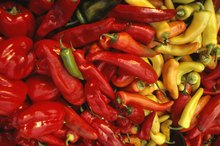The Use of Capsaicin for Shingles
Almost 1 out of every 3 people will develop shingles in their lifetime according to the Centers for Disease Control and Prevention 2. Physical symptoms from shingles are inconvenient at best and persistently painful at worst. Capsaicin, the active ingredient in chili peppers, is often recommended by doctors as one line of treatment to relieve the pain from shingles. Before using capsaicin for shingles, discuss it with your doctor.
If you are experiencing serious medical symptoms, seek emergency treatment immediately.
About Shingles
The herpes varicella-zoster virus causes chickenpox during childhood and can re-emerge as shingles later in life. After chickenpox has subsided, the virus remains dormant in the body. Older adults, particularly those over 60, are more at risk for developing shingles. Symptoms include itchiness, pain and tingling on one side of the body. A rash with blisters develops soon after, but all symptoms typically disappear in a few weeks. Sometimes, however, postherpetic neuralgia -- pain that continues after the rash has subsided -- continues for months after.
- The herpes varicella-zoster virus causes chickenpox during childhood and can re-emerge as shingles later in life.
- A rash with blisters develops soon after, but all symptoms typically disappear in a few weeks.
Capsaicin for Shingles
What Is the Incubation Period for Shingles?
Learn More
Capsaicin is the substance that give chili peppers their signature spiciness, but it can also affect the body's pain messages. Chemicals called substance P carry pain messages to the brain, but are temporarily reduced with capsaicin. Typically, doctors will recommend capsaicin in the form of topical creams for pain relief in postherpetic neuralgia. Research about shingles and capsaicin is inconsistent and success may depend on the individual.
- Capsaicin is the substance that give chili peppers their signature spiciness, but it can also affect the body's pain messages.
- Chemicals called substance P carry pain messages to the brain, but are temporarily reduced with capsaicin.
Side Effects
Using capsaicin cream for pain can cause discomfort in the form of a burning sensation at application. This is a typical effect of capsaicin cream, but sufferers of shingles often feel the burning sensation intensely. Initial pain usually dissipates after applying the cream for several days. Capsaicin may interact with some medications, including ACE inhibitors, aspirin, some asthma medications, stomach acid reducers and blood thinners.
- Using capsaicin cream for pain can cause discomfort in the form of a burning sensation at application.
- This is a typical effect of capsaicin cream, but sufferers of shingles often feel the burning sensation intensely.
Recommended Dosage
Can Shingles Be on Your Penis?
Learn More
If your doctor approves using capsaicin cream for postherpetic neuralgia from shingles, a typical dosage is to apply the cream to the affected areas four times a day. Consistent use is important in capsaicin's pain-relieving effects and will help reduce the initial intensity of burning sensations. It can take from three to seven days to see the pain-relieving effects from capsaicin.
Related Articles
References
- Therapeutics Advances in Neurological Disorders: Capsaicinoids in the Treatment of Neuropathic Pain -- A Review
- Fattori V, Hohmann MS, Rossaneis AC, Pinho-ribeiro FA, Verri WA. Capsaicin: current understanding of its mechanisms and therapy of pain and other pre-clinical and clinical uses. Molecules. 2016;21(7). doi:10.3390/molecules21070844
- Derry S, Moore RA. Topical capsaicin (low concentration) for chronic neuropathic pain in adults. Cochrane Database Syst Rev. 2012 Sep 12;(9):CD010111. doi:10.1002/14651858.CD010111
- McAlindon TE, Bannuru RR, Sullivan MC, et al. OARSI guidelines for the non-surgical management of knee osteoarthritis. Osteoarthritis Cartilage. 2014 Mar;22(3):363-88. doi:10.1016/j.joca.2014.01.003
- Gagnier JJ, Oltean H, van Tulder MW, Berman BM, Bombardier C, Robbins CB. Herbal medicine for low back pain: A Cochrane review. Spine (Phila Pa 1976). 2016 Jan;41(2):116-33. doi:10.1097/01.brs.0000249525.70011.fe
- Siemens W, Xander C, Meerpohl JJ, et al. Pharmacological interventions for pruritus in adult palliative care patients. Cochrane Database Syst Rev. 2016;11(11):CD008320. doi:10.1002/14651858.CD008320.pub3
- Moon AM, Buckley SA, Mark NM. Successful treatment of cannabinoid hyperemesis syndrome with topical capsaicin. ACG Case Rep J. 2018;5:e3. doi:10.14309/crj.2018.3
- Carey ET, As-Sanie S. New developments in the pharmacotherapy of neuropathic chronic pelvic pain. Future Sci OA. 2016;2(4):FSO148. doi:10.4155/fsoa-2016-0048
- McMillan R, Forssell H, Buchanan JA, Glenny AM, Weldon JC, Zakrzewska JM. Interventions for treating burning mouth syndrome. Cochrane Database Syst Rev. 2016;11(11):CD002779. doi:10.1002/14651858.CD002779.pub3
- Loflin BJ, Westmoreland K, Williams NT. Vulvodynia: A review of the literature. J Pharm Technol. 2019;35(1):11-24. doi:10.1177/8755122518793256
- Derry S, Rice AS, Cole P, Tan T, Moore RA. Topical capsaicin (high concentration) for chronic neuropathic pain in adults. Cochrane Database Syst Rev. 2017;1:CD007393. doi:10.1002/14651858.CD007393.pub4
- Baranidharan G, Das S, Bhaskar A. A review of the high-concentration capsaicin patch and experience in its use in the management of neuropathic pain. Ther Adv Neurol Disord. 2013;6(5):287-97. doi:10.1177/1756285613496862
Writer Bio
Pia Grant has been a freelance writer since 2007, writing on topics of health, fitness, diet and lifestyle. Her clients include websites, businesses and newspapers, including "The Voice" and "The Alumni." She has a doctorate degree in the health sciences and attended Loyola University.








